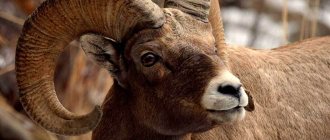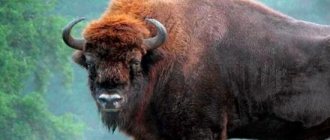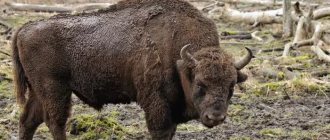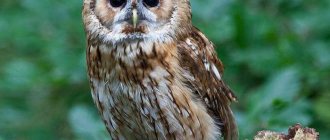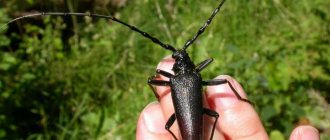The most amazing mammals from the panda family. It was not easy to classify this animal. The animal has characteristics of a marten, a predatory bear and a raccoon. The animal is no larger in size than a large cat, for which it received the nickname “cat bear”. Small pandas weigh from 4 to 6 kilograms. The body is elongated with a pointed muzzle. The head has small and rounded ears. The eyes are bright black. The body of the animal is red in color, flowing into black on the lower part of the body. The head is red with white spots, reminiscent of the color of a raccoon.
The cute face and toy appearance of this animal is popular all over the world. Due to its fur, the red panda acquired the nickname “red panda”. And in China this representative is called the “fire fox.” The animal's paws are short with rather sharp claws. Like the giant panda species, this fiery fox has an extra finger that helps it deftly handle bamboo stems. The gait is clubbed, it moves relying on one paw and periodically swings its head from side to side. These movements resemble a bear's gait.
This animal was first known in China back in the eighth century. And European scientists discovered the red panda only in the 21st century.
Red Book
The Red Book is an illustrated encyclopedia that lists environmental species that are on the verge of extinction. It first appeared back in 1902 in Paris. At this time, a number of countries signed an agreement to create the first Red Book of its kind. In honor of this, the first international convention on the protection of birds was held, which, in fact, became the first official agreement on the protection of animals.
Later, in 1948, the International Union for Conservation of Nature appeared. It included 502 organizations from 130 countries. At the conventions held, the nature conservation strategy and further actions were discussed. Today, the headquarters of the organization, which employs about a hundred people, is located in Switzerland. Its activities extend to the conservation of endangered species, as well as the management of environmental legislation systems. This organization, the creator of the Red Book, strives to ensure that all decisions on environmental activities are based exclusively on a scientific point of view.
Later, in 1949, a specialized commission on rare species of animals was created, and its tasks included studying the rarest species of animals, as well as plants that were at that time on the verge of extinction. At that time, the giant panda was not yet included in this list. An animal listed in the Red Book had to be represented by a population of less than 1000 individuals.
Today, the organization’s employees develop and prepare projects for subsequent international conventions. The main goal of the Red Book is to create a global list of animals that are soon in danger of complete extinction. In 1963, the first printed edition of the book appeared. 2 volumes contained information about 211 mammals and 312 birds. Externally, the publication looked more like a calendar, each sheet of which was dedicated to a separate species. It was initially assumed that pages would be taken out of the book as needed and replaced with new ones, with more recent summaries, but this idea was later abandoned.
The giant panda is a strange child of nature
The giant panda is a quiet, cute creature dressed in black and white. In addition to being considered the national symbol of the Wildlife Foundation, bamboo bears are considered a national treasure of China.
Despite all the attention paid to these animals today, they are endangered. Of course, the main danger is humans, since pandas have practically no enemies in nature. Now there are about one and a half thousand individuals of this amazing creature left in the wild. The giant panda from the Red Book is the rarest representative of the bear family. They live mainly in bamboo forests or high in the mountains. A panda eats from 12 to 38 kg of food per day. In order to find such an amount of food, the black and white bear has to get fruits and other supplies from the most inaccessible places. To do this, nature endowed them with enlarged bones on the wrists, which function like human thumbs.
Birth and childhood
After mating, an average of 135 days pass before the baby is born. The female gives birth to from one to three babies. But the cubs are born so helpless, and caring for them is so difficult, that the panda usually raises only one. At birth, the baby weighs no more than 150 g, and reaches a length of no more than 17 cm. The baby is born blind and without fur. In zoos, keepers have come up with a special trick: they leave only one baby for the female, replacing him with another every few days. This way it is possible to feed both babies with mother's milk.
Pandas are very caring and affectionate mothers. They cradle their “babies”, rocking them in their arms, pressing them to their chests, showing their motherly love and care in every possible way. Feeding babies can happen up to 14 times a day, so for the first few days, the mother panda does not leave her den. The duration of each feeding session is up to 30 minutes. Pandas' eyes open 3 weeks after birth, and their fur grows back by the end of the first month. At three months, a panda cub begins to walk independently, and at five months he switches to a bamboo diet. Pandas stay with their mothers from one and a half to three years, but reach sexual maturity only at six years.
Description
Despite the fact that the weight of an adult panda can reach 106 kg, this does not prevent the animal from deftly climbing trees. The giant panda, or bamboo bear, is 1.5 meters long (excluding the tail). In terms of color, nature has endowed them with unusual black “glasses” around the eyes. The nose, lips and limbs are also dark colored, while the rest of the body is white.
In some Chinese provinces, such as Sichuan, you can find pandas with a reddish tint. The Red Book giant panda lives at an altitude of 2700 to 3900 meters above sea level, but in the cold season it usually descends to 800 meters.
Behavior
Pandas prefer to be active already at dusk. Morning for them is the time when they can sit in the shade or lie down. Pandas mostly spend their lives on the ground, but can easily climb trees if necessary. Pandas are one of those animals that do not acquire their own home, because... they find shelter in caves or among forest thickets. Pandas are clean animals. In the breaks between rest and food, they spend a lot of time on their appearance, cleaning and washing for a long time. However, they do not like to swim and get caught in the rain, from which they hide in their shelters.
A panda's pose can say a lot about its intentions. If the animal shows submissiveness, it puts its head between its front paws, sometimes even covering its eyes with its paws. Pandas behave completely differently if their mood is aggressive: then they lower their heads down and look straight at the enemy from under their brows.
Adult pandas are also famous for their unusual poses. They can sit as if in a chair, imitating it, leaning their back on a tree trunk or other surface, and placing their paws on some ledge. As a rule, they use this position when doing their toilet, or simply to take a little nap. A big misconception is that pandas are considered clumsy and slow. Provided they are in danger from predators, a panda can easily roll down a mountain or quickly run away. Pandas have powerful claws that grow up to 4 cm, which they can use as weapons against opponents.
Although pandas prefer a solitary lifestyle, they also have to communicate with each other. They do this using a certain set of sounds, and each sound has its own for different situations. If a panda is in pain or showing submission, the sound it makes is reminiscent of a squeal. During the process of mating, pandas “chirp” like a bird, and in moments of danger they make sounds reminiscent of a goose cry. “Goat” bleating should be regarded as an invitation to communicate in a friendly manner, and slurping serves as a signal of a retaliatory threat.
A special means of communication is smells, with the help of which pandas let others know about something. They even have special places where they leave their messages, and also come to read the “messages” of their brothers. Surprisingly, pandas have a means that allows them to attract sympathy. The fact is that pandas, with the help of their sweat glands, have the ability to secrete a special secretion containing pheromones. This helps pandas very well in case of danger, because... volatile compounds that control neuroendocrine behavioral reactions reduce the level of aggression. This is also how scientists explain the love for these animals that arises in everyone who has experienced the effect of a secret at least once in their life, multiplied by the natural charm of pandas.
Sixth finger
As you know, pandas have a sixth toe, which is not actually hemological for this species. The appendix was formed as a result of deformation of one of the bones in the wrist.
This fact is still being studied by specialists, and scientists continue to conduct research regarding the species identity of black and white bears, and also debate in which section they should be listed in the International Red Book. The giant panda is generally the subject of much debate among biologists.
People among pandas
In 1996, in one of the regions of China, hunters accidentally caught a child covered with fur and behaving like a panda. The child was found among these animals. The boy was born with numerous genetic abnormalities. The body was covered with thick hair. Apparently, this allowed the pandas to accept the human child as their own and raise it.
The pandas raised the child according to their own ideas, so he moved exclusively on all fours, licked himself, and ate bamboo shoots. Apart from a few minor differences, the panda boy behaved exactly like his “adoptive parents.”
After the child was placed among people in a foster family, he continued to behave for some time like his former teachers. However, after some time, the boy began to adopt human habits and skills, learned to stand and speak. He was then taken to a Beijing institute for research.
Classification
For many years, there has been debate that the panda may belong to the raccoon or bear family. The possibility of giving bamboo bears a personal family, which would be called “panda bears,” was also discussed. However, after molecular tests, scientists came to the conclusion that the DNA of pandas most closely matches the cellular structure of bears. According to the tests, it was also revealed that these animals separated from the usual clubfoot about 15-25 million years ago. After the bamboo bear appeared in a publication known as the International Red Book, the giant panda became the object of even closer study.
Pandas and Russia
In Russia, the first panda appeared in 1957 at the Moscow Zoo. The first panda's name was Pin-pin. Soon the zoo acquired another panda named An-an. The employees of the Moscow Zoo wanted to create a couple and then wait for offspring from their new pets. However, it turned out that An-an is also a male. And only 4 years later, the Chinese authorities helped Moscow and picked up a female named Chi-chi. However, this did not bring success either. Either Chi-chi didn’t like her partners, or it was due to the lack of attraction to individuals of the opposite sex, characteristic of pandas living in captivity. And the bride was sent back.
Reproduction
Pandas mate exclusively in the spring. Pregnancy in females lasts approximately 5 months. This uncertainty is due to the fact that sometimes implantation of the embryo into the uterus is delayed. After 5-6 months, up to 3 cubs are born. However, in the end, only one baby survives.
Animals reach sexual maturity at the age of 6 years. Considering the fact that the lifespan of bamboo bears is 14 years, it is not surprising that the panda is now a rare animal in the Red Book. On top of this, females are only capable of breeding for a few days a year. During this period, pandas completely change and turn from cute teddy bears into aggressive tyrants. Therefore, during the mating season, males do not see anything around, but only try to win the attention of a beautiful female. When arranging fights, rivals can bite, scratch and fight tooth and nail. The loser may be left without a partner until next year. But this does not mean that the winner gets everything, since the female may well refuse the winning male if she is not sure that it is from him that she will receive healthy and strong offspring.
Interesting facts about pandas
- Bamboo bears are distinguished by a special structure of their front paws: the usual five fingers are opposed to the sixth, which is a modified sesamoid bone. An additional finger makes it easier for the animal to eat bamboo, helping to hold the torn stems.
- In the entire history of China, only a few dozen cases are known when pandas were legally exported from the country as gifts to other rulers or to be kept in zoos. Currently, animals are given to zoos exclusively for rent, with the condition that if cubs appear, they will be the property of the PRC.
- The panda is listed in the Guinness Book of Records as the most attractive wild animal.
- To protect and increase the panda population in China, over the past decades, more than 50 reserves and nature reserves have been created, with a total area of more than 1 million hectares.
- The importance of pandas in nature lies in the fact that the animals carry bamboo seeds in their excrement, contributing to the spread of this plant.
Animals of the Red Book: giant panda
This species is today on the verge of extinction and is officially listed in the Red Book. According to the most reliable data, in the mid-90s there were less than 1000 individuals in the world. And this despite the fact that in China there are quite strict laws regarding the killing of pandas. For such a crime there was only one sentence - the death penalty.
But alas, despite all the severity towards poachers, the giant panda continued to be destroyed because of its extraordinary fur. The Red Book, whose message about the extinction of these animals literally shocked the “greens,” paid great attention to bamboo bears in the latest edition.
How many pandas are there in the world 2022?
The number of captive giant pandas in the world reaches 600 CHENGDU, Nov. 13 (Xinhua) -- The number of captive giant pandas in the world has reached 600 in 2022, according to the latest data released.
Interesting materials:
How long can you carry a child? How long should parents support their children? How long does it take for a child’s collarbone to heal? How long does it take to heal after a baby's circumcision? How long to wait for child benefits? How does the baby move at 23 weeks? How to ride the subway with a child? How to vote for Junior Eurovision 2022? How to cook Dairy-free porridge for a child? How and when to wean your baby off night feedings?
Lifestyle
Although pandas are carnivores, like their relatives bears, the basis of their diet is vegetarian food. But nevertheless, animals still need protein, which can be obtained exclusively from animal food.
The panda eats most of the day and sleeps the rest of the time. Because of this more than measured lifestyle, funny bears become excellent models for tourists, who post thousands of touching photos all over the Internet.
Bamboo bears sleep mainly in trees, although in moments of laziness they can also settle on the ground. Despite their seemingly clumsy nature, pandas are great at climbing trees.
What do they eat
Chinese pandas are classified as carnivorous mammals, but most of their diet consists of plant foods. The panda eats bamboo for half the day, consuming up to 25-30 kg of green mass per day. Usually the animal chooses young and succulent parts of the plant, but if necessary, it can also eat tougher and drier stems. The bamboo bear's digestive system is fully adapted to eating and digesting tough plant foods.
When there is a shortage of bamboo, the panda feeds on the leaves of vines, vines, bark, stems and leaves of some trees. From time to time, the animal can eat bird eggs, insects and their larvae, worms, rodents and small birds.
Sluggish and plant-loving pandas are often confused with other eucalyptus-loving koala bears. In fact, bamboo and marsupial bears have significant external differences, different habitats, and also eat different foods.
